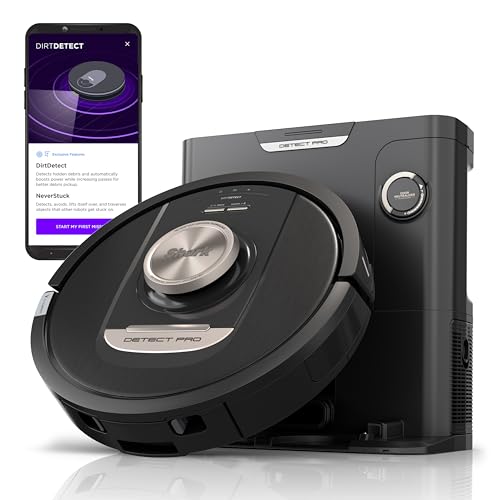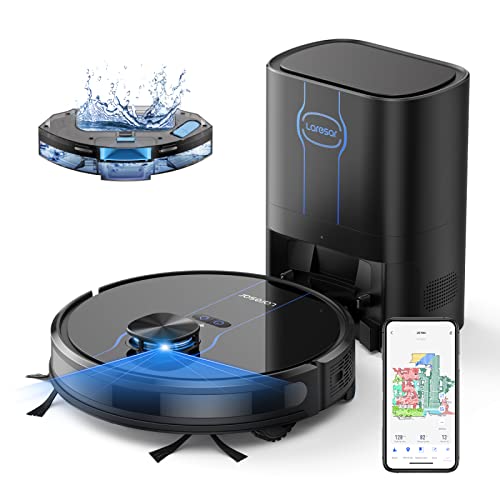See What Bagless Automated Sweepers Tricks The Celebs Are Utilizing

2024-09-04 04:49
63
0
본문
Bagless Automated Sweepers
 There's a new era of robot vacuums that don't require bags. Bagless models make use of dirt compartments made of plastic that trap debris. They then empty them into an empty bin at the base station. They typically have low or no recurring costs, except for changing filters, which can be cleaned.
There's a new era of robot vacuums that don't require bags. Bagless models make use of dirt compartments made of plastic that trap debris. They then empty them into an empty bin at the base station. They typically have low or no recurring costs, except for changing filters, which can be cleaned.
Our top pick comes with 5,300Pa of suction power, self-emptying into a bagless base station that can hold about a month's worth of debris. It also has a smart mopping mode.
Easy to empty
In contrast to vacuum cleaners that utilize bags, bagless sweepers have dirt receptacles that are easy to clean and empty. The trash bin is easily removed from the lock and emptied. There's no bag to lose or open, so it's much more convenient than changing bags on bags on a bagged sweeper.
Many bagless robots also feature self emptying robot vacuum bagless-emptying bases which eliminate the need for manual maintenance. The base can last for a long time without having to be empty. For models that mop the water, it could last for multiple cleaning sessions. It's crucial that the dock or Self Empty Base be positioned in a spot where it won't interfere with the robot's sensors or hinder it. It is also recommended to use it only for dry sweeping.
It is possible to observe the amount of dirt and debris that's been collected by the robot as you empty it. This is a great way to keep on track of the amount of dirt and other debris that has been collected by the robot.
The clear plastic containers also help you locate lost items, like Little Mary's or Jimmy's doll barrette that may have been sucked up by the vacuum. There's nothing more frustrating than a missing toy, so having a visible bin can help you find it, and eliminate the hassle of searching through a messy bag for a long time.
The bins that are used by bagless robotic sweepers might be easier to empty than vacuums that have bags. However, they require cleaning and washing frequently. They are simple to clean and can be completed by any homeowner. bagless intelligent robot sweepers may also have filters inside that need to be washed or replaced, based on the model of the vacuum. These are still relatively small cost that is significantly less expensive than the cost of replacing bags in bags in a bagged vacuum.
Better Cleaner
Many bagged sweepers stop working at their peak performance when the bags are full, which results in poor cleaning performance. Bagless systems on the other hand, continue to perform well even when they are at capacity. This ensures consistent, high-quality cleaning over the entire sweep.
In addition, most bagless models have a bigger debris bin than bagged counterparts. This means they are able to collect larger objects, such as wood shavings and metal screws than the smaller bins that are found on bagged models. This is particularly useful when cleaning stairs and corners where dirt tends gather.
Finally, because bagless automatic vacuums styles do not use disposable bags, they're a more eco-friendly option. In contrast, bagged vacuum cleaners need hundreds of bags over their lifespan, placing an unnecessary burden on the environment.
Easy to maintain
bagless robot vacuum and mop sweepers use an integrated canister to store debris and dirt, so there's no need for vacuum bags. This system also makes bagless sweepers a more green option than bags-filled counterparts. Bagged vacuum cleaners make use of hundreds of bags to dispose of their lifespan, which adds up to a substantial amount of waste. Bagless models require only one upfront investment. This can reduce the long-term cost and environmental impact.
 There's a new era of robot vacuums that don't require bags. Bagless models make use of dirt compartments made of plastic that trap debris. They then empty them into an empty bin at the base station. They typically have low or no recurring costs, except for changing filters, which can be cleaned.
There's a new era of robot vacuums that don't require bags. Bagless models make use of dirt compartments made of plastic that trap debris. They then empty them into an empty bin at the base station. They typically have low or no recurring costs, except for changing filters, which can be cleaned.Our top pick comes with 5,300Pa of suction power, self-emptying into a bagless base station that can hold about a month's worth of debris. It also has a smart mopping mode.
Easy to empty
In contrast to vacuum cleaners that utilize bags, bagless sweepers have dirt receptacles that are easy to clean and empty. The trash bin is easily removed from the lock and emptied. There's no bag to lose or open, so it's much more convenient than changing bags on bags on a bagged sweeper.
Many bagless robots also feature self emptying robot vacuum bagless-emptying bases which eliminate the need for manual maintenance. The base can last for a long time without having to be empty. For models that mop the water, it could last for multiple cleaning sessions. It's crucial that the dock or Self Empty Base be positioned in a spot where it won't interfere with the robot's sensors or hinder it. It is also recommended to use it only for dry sweeping.
It is possible to observe the amount of dirt and debris that's been collected by the robot as you empty it. This is a great way to keep on track of the amount of dirt and other debris that has been collected by the robot.
The clear plastic containers also help you locate lost items, like Little Mary's or Jimmy's doll barrette that may have been sucked up by the vacuum. There's nothing more frustrating than a missing toy, so having a visible bin can help you find it, and eliminate the hassle of searching through a messy bag for a long time.
The bins that are used by bagless robotic sweepers might be easier to empty than vacuums that have bags. However, they require cleaning and washing frequently. They are simple to clean and can be completed by any homeowner. bagless intelligent robot sweepers may also have filters inside that need to be washed or replaced, based on the model of the vacuum. These are still relatively small cost that is significantly less expensive than the cost of replacing bags in bags in a bagged vacuum.
Better Cleaner
Many bagged sweepers stop working at their peak performance when the bags are full, which results in poor cleaning performance. Bagless systems on the other hand, continue to perform well even when they are at capacity. This ensures consistent, high-quality cleaning over the entire sweep.
In addition, most bagless models have a bigger debris bin than bagged counterparts. This means they are able to collect larger objects, such as wood shavings and metal screws than the smaller bins that are found on bagged models. This is particularly useful when cleaning stairs and corners where dirt tends gather.
Finally, because bagless automatic vacuums styles do not use disposable bags, they're a more eco-friendly option. In contrast, bagged vacuum cleaners need hundreds of bags over their lifespan, placing an unnecessary burden on the environment.
Easy to maintain
bagless robot vacuum and mop sweepers use an integrated canister to store debris and dirt, so there's no need for vacuum bags. This system also makes bagless sweepers a more green option than bags-filled counterparts. Bagged vacuum cleaners make use of hundreds of bags to dispose of their lifespan, which adds up to a substantial amount of waste. Bagless models require only one upfront investment. This can reduce the long-term cost and environmental impact.


댓글목록0
댓글 포인트 안내